The gods of northern Buddhism
their history, iconography and progressive evolution through the northern Buddhist countries
by Alice Getty | 1914 | 98,662 words
Indispensable reference for art historians, scholars of Eastern philosophy and religion. Wealth of detailed scholarly information on names, attributes, symbolism, pictorial representations of virtually every major and minor divinity in Mahayana pantheon, as worshipped in Nepal, Tibet, China, Korea, Mongolia, and Japan. 185 black-and-white illustrat...
| [1]Table XI | ||||||||||
|
The Yi-dam. |
|
I. Derived from Dhyani-Buddhas. |
|
I. Vajra at his feet . . . . | I. Vajrasattva. | |||||
| II. With sahti, holds bell and |
|
cakra. |
|
II. Vairocana. | ||||||
| vajra. | III. Akshobhya. | |||||||||
| cintamani. | IV. Ratnasambhava. | |||||||||
| patra. | V. Amitabha. | |||||||||
| visva-vajra. | VI. Amoghasiddha. | |||||||||
| II. Derived from the Bodhisattva Manjusri. | VII. Manjuvajra.[2] | |||||||||
| III. Derived from Dharmapala. |
|
Vajrapani. | VIII. Mahacakra.[3] | |||||||
| Manjusri. | IX. Yamantaka. | |||||||||
| Kuvera. | X. Jambala.[4] | |||||||||
| IV. Forms purely Yi-dam. |
|
I. Seven heads, sixteen arms, four legs | XI. Hevajra. | |||||||
| II. Less than seven heads. |
|
I. Three heads, six arms | XII. Sang-dui. | |||||||
| II. Four heads. |
|
I. Four arms. |
|
XIII. Mahamaya. | ||||||
| II. Twelve arms. |
|
XIV. Samvara. | ||||||||
| XV. Kalacakra. | ||||||||||
Every lama puts himself under the protection of a special Yi-dam. He prepares himself for the event by solitude, meditation, and asceticism, after which, if the divinity accepts the guardianship, he will reveal himself when the lama is in a proper meditative state. The Yi-dam may be chosen for a lifetime, or for a given enterprise. A lama may even choose several at a time, but his choice must be kept secret to be efficacious.
It is possible for a layman to be put under the protection of a Yi-dam through the intercession of a lama; but he cannot appeal directly to his tutelary god, he can only do so through a lama. Tara is the only divinity of first rank to whom a layman may appeal directly.
The Yi-dam are almost invariably represented with their sakti. In fact, the ydb-yum attitude is the Yi-dam form of the five Dhyani-Buddhas. It is considered that a tutelary god is more efficacious if worshipped in company with his consort.
The god-protectors have the rank of Buddha and are divided into two classes: the 'mild' and the 'angry' types.
The 'mild' Yi-dam are 'crowned' Buddhas represented with the thirteen ornaments of the Bodhisattva. They hold the usual symbols: wheel, rosary, lotus, jewel, &c.
The ' angry ' Yi-dam are less fierce in aspect than the Dharmapala. They wear the crown of skulls, but the skulls are smaller and are ornamented by Bodhisattva ornaments. The hair is drawn up in a high ushnisha, and they wear many ornaments besides the long garland of heads. Their symbols are Tantra: skull-cup, vajra, chopper, &c, and, if painted, their colour is blue.
(T.) kye-ba-rdo-rje (oh, eternal thunderbolt!).
(M.) kevajra.
Symbol: kapala.
Colour: blue.
The tutelary god Hevajra is described, with all the rites and ceremonies used in his worship, in the sutra of the Hevajra tantra, which figured historically in the conversion of the Mongolian emperor Khoubilaii in the thirteenth century A. D. [5]
Hevajra is represented with eight heads, sixteen arms, and four legs. There are three heads on either side of the central head, which is larger than the rest, and all have the third eye. Above the central head is another head. The heads, however, may be disposed in two tiers of three, with a head on top. In this form there are only seven heads.
All of the sixteen hands hold skull-cups. In those at the right are figures of animals: an elephant, a horse, a mule, a bull, a camel, a man, a deer, and a cat.
In the skull-cups held by the left hands are personages which, according to Grunwedel, are:
- God of the water — Varuna: yellow.
- God of air — Vayu: green.
- God of fire — Agni: red.
- God of the moon — Candra: white.
- God of the sun — Surya: red.
- God of death — Yama: blue.
- Goddess of riches — Vasudhara: yellow.
- A terrestrial god — (?): yellow.
The colour of Hevajra is blue, and the three heads at the right of the central head (which is blue) are red, blue, and white. The three heads at the left are yellow, brown, and blue. The eighth head, which surmounts them, is a reddish brown.
Two of the legs step to the right on human beings, while the two legs at the back are in dancing position.
He is generally represented in yab-yum attitude (PI. XLV; and PI. xliv, fig. a), and the Sakti, who encircles the body of the yum with her legs, holds a grigug in her outstretched right arm, while the left is around the neck of the god. Both the yab and the yum wear many ornaments, and all the heads are crowned, either with the skull or the Bodhisattva crown. Hevajra wears a long garland of heads, as well as the usual Bodhisattva scarf, and from a girdle hang many ornamented ribbons. If painted, he is blue as well as the sakti.
(S.) Guhyasamaja.
(T.) dpal gsan-ba-hdus-pa (the secret assembly).
(C.) Kuan-tsi-tsai fa.
Symbols: cahra (wheel), cintamani (magic jewel), vajra (thunderbolt).
Sang-dui belongs to the mild type of Yi-dam and is dressed like a Bodhisattva, or rather a 'crowned' Buddha, for he has the rank of a Buddha. He is always represented seated, and has three heads. Each head has a five-leaved crown. In the central leaf of the crown, on the middle head, there is generally a wheel, and his high ushnisha is surmounted by a flaming pearl. He has six arms. The original ones are crossed behind the back of the sakti and hold the vajra and ghanta. The others hold the wheel, magic jewel, &c. The Sakti also has three heads, and in the central leaf of the crown, on the middle head, is a small image of Amitabha. She has six arms and holds the same symbols as the yah.
Mahayama (Yi-dam)
(T.) ma-hha, mha-yak, or tsans-pa (Brahma).
(C.) Ta-huan-kin-kang.
Symbols: kapala (skull-cup), capa (bow), sara (arrow).
Colour: blue.
Mahamaya is the Yi-dam form of Brahma and, as a 'mild' Yi-dam, is dressed like a 'crowned' Buddha. He has four heads, on each of which is a Bodhisattva crown, and he does not have the third eye. He has four arms, the two normal ones are crossed at the back of the sakti and hold each a kapala. The other hands hold a bow and arrow. There is sometimes a human skin over the shoulders. The sakti also holds a bow and arrow. Mahamaya is generally seated, but may be standing, in which case he rests on one foot while the other is raised, as if he were dancing. In this case he, however, holds the sakti in the same attitude as if he were seated.
(T.) bde-mc'og (the best happiness).
(C.) Sanpa-lo (![]() )
)
Mudra: vajra-hum-kara (arms crossed on breast).
Special symbol: four-faced head of Brahma.
Colour: blue (sakti, cherry).
Samvara is believed to be incarnate in the Dalai-lamas of Peking, and his place of pilgrimage, in the province of Tsa-ri, is visited not only by Chinese Buddhists but by pilgrims from Nepal and Tibet.
As Yi-dam he has the rank of Buddha, and is the most complicated manifestation in the group. His four heads, if painted, are: the central one, blue; the one at the right, white; the one at left, green; the one at the back, red. On each head is a crown of five skulls, above each of which is a flaming pearl, or an ornament like that on the Bodhisattva crowns.
In the central ornament may be the small image of a Dhyani-Buddha. The high ushnlsha is surmounted by a flaming pearl, and is decorated, at the left by a half-moon, and in front by a double thunderbolt. Each face has a third eye and angry expression.
He is represented with twelve arms. The original ones are crossed in vajra-humkara mudra, and hold the vajra and ghanta (thunderbolt and bell). The upper arms hold an elephant skin, which entirely covers his back (PI. xlvii, figs, c and d). The others hold the head of Brahma (four-faced), a khatvanga (magic wand), and other Tantra symbols. He wears a long garland of heads, and in the illustration in Pander's Pantheon he has a tiger-skin hanging from the waist. He steps to the left on the nude figure of a four-armed woman holding a khatvanga, and on the right treads on a four-armed man with a tiger-skin covering. The group is on a lotus with jagged petals.
Like all the Yi-dam, he is often represented with his Sakti, whom he clasps to his breast, his arms crossed behind her back. The Sakti holds a skull-cup and a chopper, and, if painted, is cherry colour, while Samvara is blue. There may be a glory of flames [6] surrounding the group.
There is an example of Samvara (PI. xlvi, fig. b) which, as far as the author knows, is unique. He is seated on the mule of Lhamo with the eye in the haunch, and holds a Sakti, which is probably Lhamo herself.
In the Museum fur Volkerkunde in Berlin there is a most curious fresco of Sarpvara, brought from Turfan by Herr von Le Coq.
(Wheel of the Time).
(T.) dus-k'or (wheel of time).
(M.) cagh-un kurde (he who turns the wheel of time).
Mudra: vajra-hum-kara.
Symbols: vajra (thunderbolt), khadga (sword).
Colour: dark blue, or tricolour (blue, white, red), sakti (orange).
Although the god Kalacakra is represented in all the Tibetan paintings of the Tsok-shin, or assembly of the gods, he is but rarely mentioned in the Northern Buddhist texts. As Kalacakra is the title of a work in one of the divisions of the Kanjur, on a mystic system in Nepal (also called Kalacakra). it is possible that the god Kalacakra is a personification of that work, in the same way that Hevajra personifies the Hevajra Tantra, and the goddess Prajnaparamita, the Prajnaparamita, or Treatise on Transcendent Wisdom.
In the temple banners Kalacakra is represented either as a Bodhisattva or a Yi-dam. As a Bodhisattva he wears a five-leaved crown, the traditional Bodhisattva ornaments, and is yellow; but this form is very rare. He is usually represented as a Yi-dam with four heads, on each of which is a third eye. He may have twelve or twenty-four arms, but never has more than two legs. In his Yi-dam form he is dark blue, his body is covered by a tiger-skin, and he wears a belt formed of vajras.
Kalacakra is always represented in the yab-yum attitude, and may hold his sakti, with either two or four arms. If the former, he carries a vajra and ghanta. If the latter, he holds two vajras, a flaming sword, and a symbol difficult to determine. In a Tibetan drawing belonging to M. Deniker [7] he has twenty-four arms and holds many symbols, among which are, at the right: a flaming sword, a trident, a chopper, an arrow, an axe, &c. At the left his hands carry: a khatvahga, a kapala, a bow, a lasso, &c. These symbols, however, vary in the different Tsokshin. In the Three hundred Burquan of Oldenburg, Kalacakra has only twelve arms.
He is always represented stepping to the left on two prostrate personages or demons, with four arms. The personage under the right foot holds a bow and arrow; the one under the left a trident and khatvahga. There are sometimes two other demons who seem to be supporting the heels of the god, but may be also represented supporting the heads of the prostrate personages.
The sakti is represented with only one head, in the Pantheon des Tschangtscha Hutuktu of Pander, No. 65, but in the text she is mentioned as having four heads, which is her usual number (v. Frontispiece). She may, however, have only two heads, and always has eight arms. With one of her arms, at the left, she encircles the neck of the god, while the others carry various symbols: a lasso, a flower, a grigug, a vajra, &c, and one hand may be making a mudra. Her two legs are parallel with those of Kalacakra and step on the same personages; her colour is orange.
In one of the temple banners of the Tsokshin, belonging to M. Bacot, Kalacakra is represented with the central head blue, that to the right white, while the two to the left are yellow and red. Of his twenty-four arms, eight are blue, eight are white, and the other eight are red. The right leg is white, and the left red. The sakti is orange in all the Tsok-shin.
| PLATE XLIV | ||
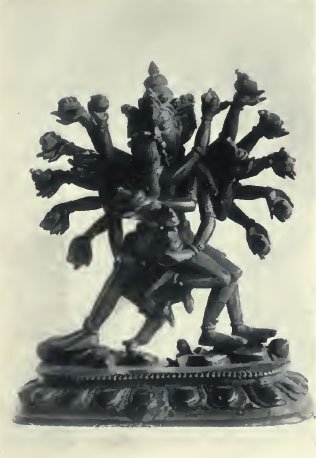 |
.jpg) |
|
| a. Hevajra with his sakti | b. Hayagriva | |
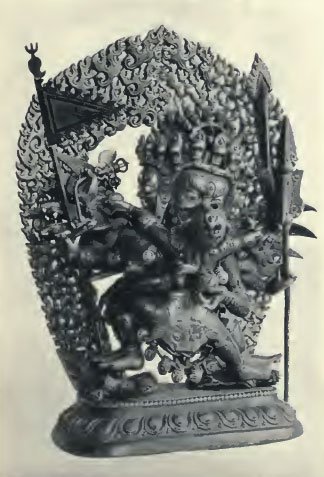 |
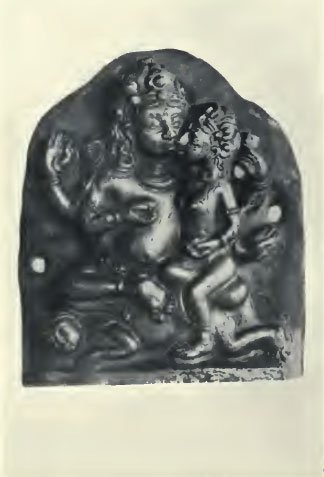 |
|
| c. Hayagriva with his sakti | d. Kuvera (Nara-vahana) with his sakti | |
| Plate XLV |
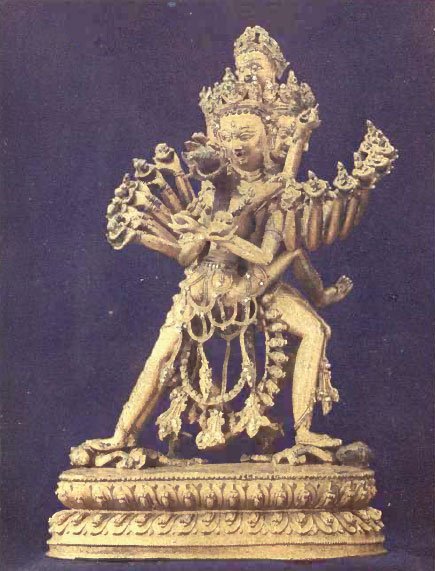 |
| Hevajra |
| PLATE XLVI | ||
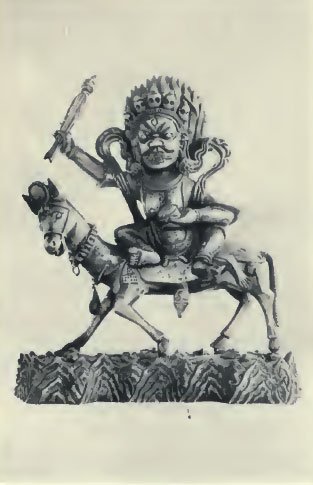 |
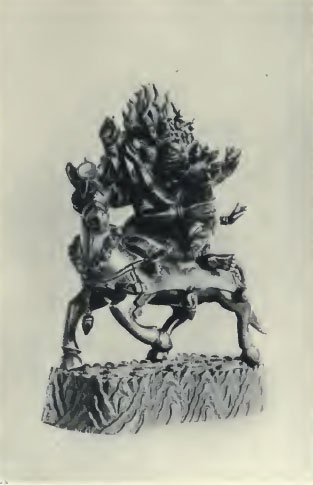 |
|
| a. Lhamo |
b. Samvara on the mule of Lhamo (Lhamo as sakti ?) |
|
| PLATE XLVII | ||
.jpg) |
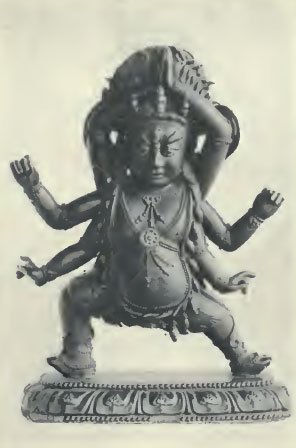 |
|
| a. Yama | b. Yama | |
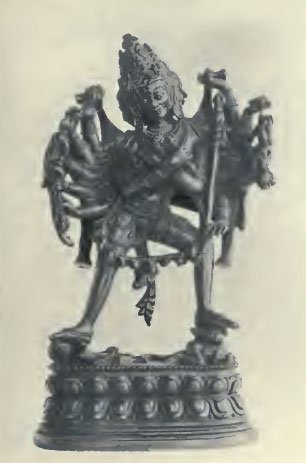 |
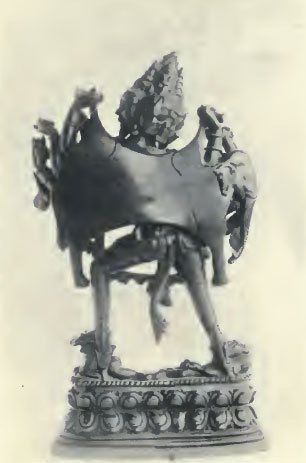 |
|
| c. Samvara | d. Samvara | |
Footnotes and references:
[1]:
Table of J. Deniker.
[2]:
Manjusri.
[3]:
v. Vajrapani.
[4]:
v. Kuvera.
[5]:
v. Muhakala.
[6]:
Illus. 63, Das Pantheon des Tschangtscha Hutuktu.
[7]:
I am indebted to M. Deniker for various iconographic details in this study.
